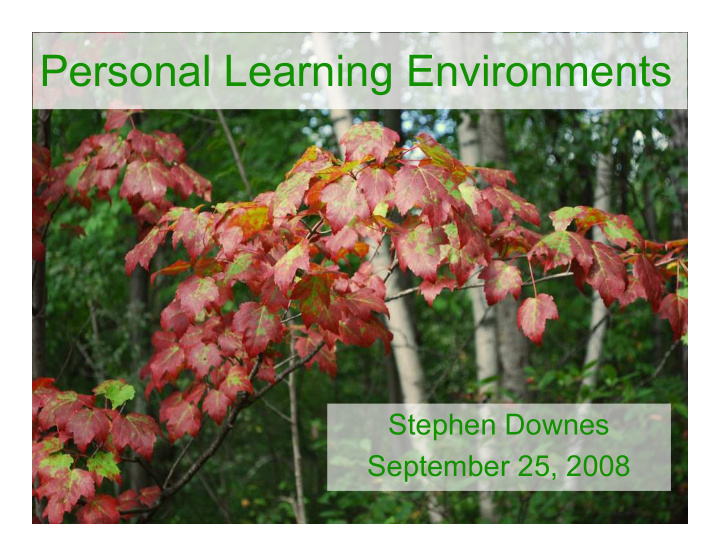



Personal Learning Environments Stephen Downes September 25, 2008
What is my personal learning environment?
• A place to store (and share) my photos http://www.flickr.com
• A place to store (and share) my videos http://video.google.com/videoplay?docid=-4126240905912531540
• A place to write an essay with my colleague in Montreal http://docs.google.com
• A way to stay up to date - right up to date http://www.google.com/reader
• A way to save on phone calls http://www.skype.com
• Knowing where I’m staying before I get there http://maps.google.com
• An Easy Way To Draw Pictures http://www.gliffy.com
What do personal learning environments mean for learners?
• A world of free learning resources… http://educationvault.blogspot.com/2008/08/zaidlearn-ocw-oer-lists.html Don’t like the word ‘free’? Deal with it…
Three Views of Learning Resources:
1. Learning Resources as a thing –Book, content object, etc
2. Learning Resources as events – Class, lecture, seminar, meeting
• The first two models are information-theoretic and medium-based models –They stress content –They stress rules
3. Learning Resources as flow – Stresses experience – Stresses pattern recognition
What does this look like?
• User generated Content –Personal, opinionated
• Network of interactions
• Immersive Learning
• New Roles – For students - as creators of learning – For teachers - as coaches and mentors – For the rest of us - as teachers
• Web of user-generated content (eg. Wikipedia)… http://www.wikipedia.org
Learning as a network phenomenon…
Issues: • Too much information, filtering info • Too many sources to scan, new sources • Localization, personalization, relevance
Response: Network Semantics http://epthinking.blogspot.com/2008/08/on-event-processing-network-and.html
• Social networks and communities (entails a genuinely portable (and owned ) identity http://www.facebook.com
• Networks of interactions (aggregate, remix, repurpose, feed forward) – syndication An ecology…
• The personal learning centre Autonomy http://blog.core-ed.net/derek/2006/11/more_on_mles_and_ples.html
• The Network is Diverse – multiple views, multiple technologies http://flickr.com/photos/11242012@N07/1363575474
• The Network is connected and interactive ( not ‘integrated’) – small pieces, loosely joined http://www.biography.org.uk/real.htm
• The Network is open http://park.org/Japan/NTT/DM/html_f4/F4_10600_e.html
What are the key technologies? http://www.bclir.org/Egypt.htm
Web 2.0 - Core Technologies Tools for worldmaking…
Social Networking http://staffdev.henrico.k12.va.us/parents/socnetwork.htm
Tagging
Asynchronous Javascript and XML (AJAX) Jesse James Garrett in February 2005. https://bpcatalog.dev.java.net/ajax/textfield-jsf/design.html
Representational State Transfer (REST) - principles that outline how resources are defined and addressed - looser sense: domain-specific data over HTTP http://en.wikipedia.org/wiki/Representational_State_Transfer http://itpro.nikkeibp.co.jp/article/Watcher/20060315/232492/
Application Program Interface (API) and Mash-Ups http://scenariothinking.org/wiki/images/b/b6/MashUpSysDiagramV6.0.jpg
Javascript Object Notation (JSON)
OpenID http://gabinetedeinformatica.net/wp15/2007/03/09/openid-nuestra-identidad-virtual/ http://www.funnymonkey.com/openid-in-education
Thanks! http://www.downes.ca
Recommend
More recommend